Sep 25 2016
Saturday – 2 speed Lactate test and some thinking
Time for the 2 speed lactate test again. The protocol is simple.
- Do a thorough warming up
- Row a 1k “at 6k pace”
- Take 15 minutes active rest, measuring lactate at 1 and 3 minutes
- Row a full out 1k
- Row a cooling down, measuring lactate at 1, 3, 5 and 10 minutes.
Then you plot the 1 minute values against power.
I started with a 20 minute warming up:

Then I did the first 1k:

Pretty evenly paced. I measured 5.4 mmol/L of lactate after 1 minute and 4.5 mmol/L after 3 minutes. I paddled until 15 minutes was gone, at roughly 150-160W pace.
Then I did the second 1k:

I knew this wasn’t going to be a very fast 1k, so after 10 hard strokes at the start, I settled for 300W, then tried to crank it up with 500m to go.
So here is the result (lactate in mmol/L).
| Measurement | Lactate | Power |
| 1 min | 5.4 | 270 |
| 3 min | 4.5 | |
| 1 min | 6.1 | 315 |
| 3 min | 8.1 | |
| 5 min | 7.2 | |
| 10 min | 4.3 |
The droplet of blood after 1 minute after the full out 1k was a little smaller than normal. I think the measurement was OK. It seems the lactate concentration in the muscle was just much higher and it took time to flush out the lactate. This would explain the higher value after 3 minutes.
Here is the graph of all 2 speed tests I had done in the past 12 months:
The chart looks like a game of Mikado (or pick-up sticks) and it is hard to understand what is going on. I have been rereading on Lactate, especially this article. I picked up my old simple numerical model and tried to model the recent three series of lactate step tests I did in September.
Not an ideal fit but it is interesting to look at the parameters.
| Nov ’15 | Sep ’16 | ||
| Pthreshold | 200 | 195 | W |
| beta | 0.1 | 0.15 | |
| C_La rest | 0.7 | 1.5 | mmol/L |
| V_La_max | 0.1 | 0.2 | mmol/L/s |
Pthreshold is the threshold Power. The parameter “beta” is a parameter which governs lactate usage as fuel in the aerobic pathway (higher values mean more lactate can be used as fuel during aerobic exercise). “C_La_rest” is the rest value of lactate (which I measured today), and “V_La_max” is a parameter which governs how fast lactate is produced once you are above the threshold. So the hypothesis is that my threshold power has shifted to the left (bad), but I am better at burning lactate during aerobic exercise. At the same time, I have become better at producing a lot of lactate when above the threshold.
The model should be taken with a very big grain of salt. It’s all very crude and simplified at the moment. Take it as an illustration of my current understanding of lactate “science”. Instead of looking at individual test results, you have to build a model of how blood lactate is generated and used. In “Olbrecht” language, my Aerobic Capacity has slightly decreased, but my Anaerobic Capacity has improved a lot.
Now, if I knew what that means in terms of race performance, and how to use the result to fine tune my training plan … that would be great.
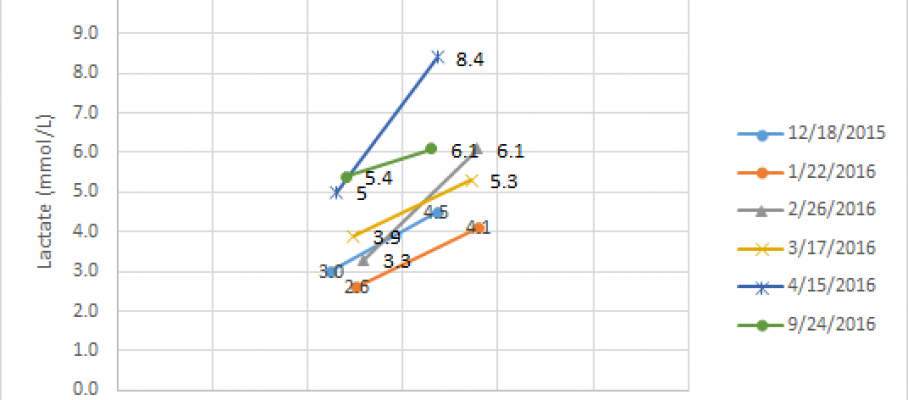
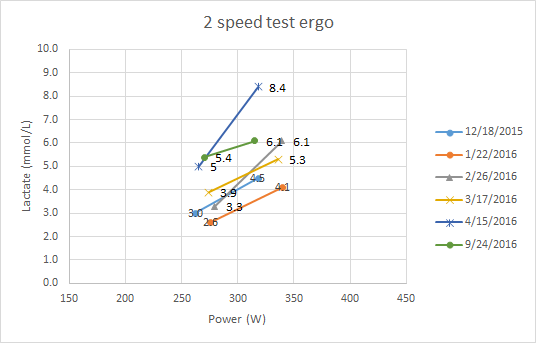
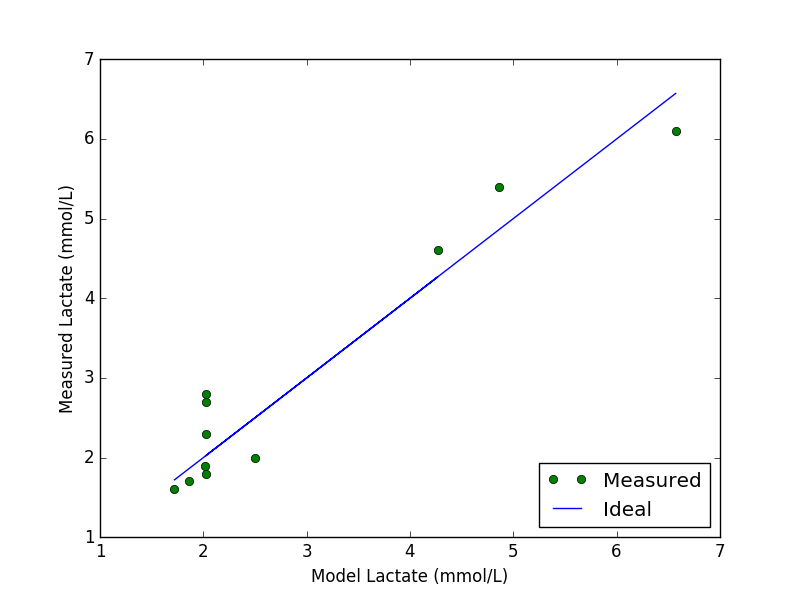
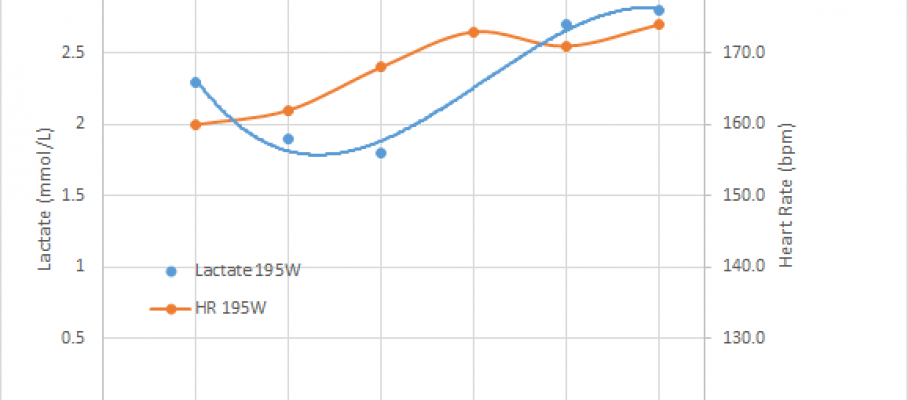
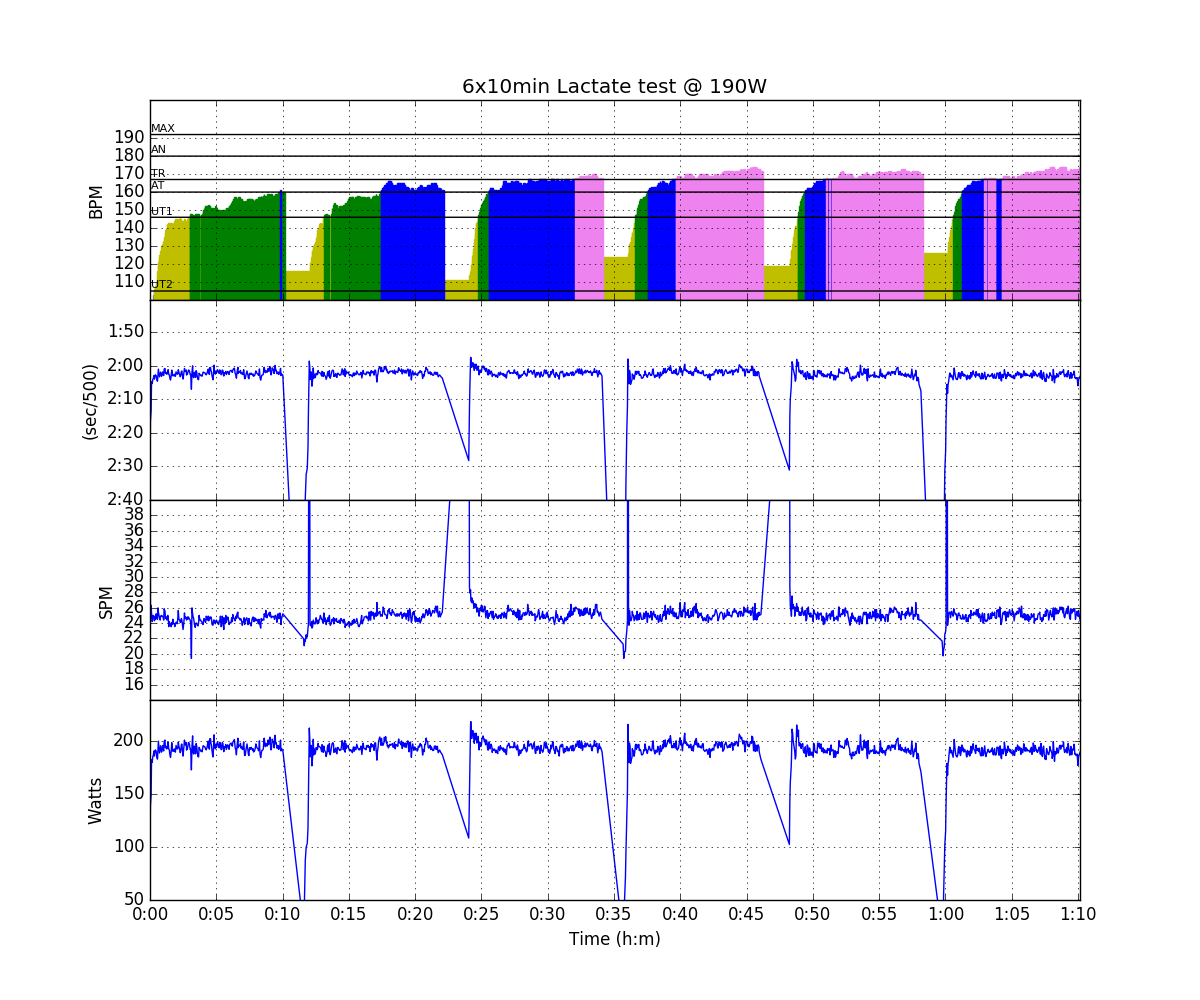
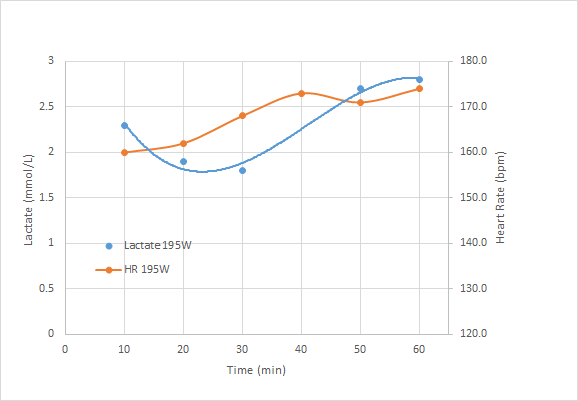
Sep 24 2017
On being a prick (a steady one)
Sorry for the title. Couldn’t resist.
I tried to make an hour of steady state on the erg a bit more interesting. On Friday, I had tried to use Kinomap and wasted 10 minutes of precious exercise time trying to revive my Kinomap account. Didn’t work. I think I am going to uninstall Kinomap from my devices. It is never straightforward, and it is always taking more time than I want.
So I dusted off my lactate meter and decided to take measurements every ten minutes. I did a baseline measurement before the row, which gave me a nice 1.2 mmol/L value. That was slightly higher than expected, but OK.
Down to the erg room. Dialed up a 10 minute and rowed. I decided to aim for a 200W average, which is probably higher than I should row my steady state, but I wanted the lactate readings to tell me that. You basically want to see that the blood lactate concentration keeps rising steadily during the entire hour.
The dip after a few minutes is when I decided to stop erging and increase the volume on my radio. I was listening (again) to the BroShow podcast on training planning and the volume was too low to hear anything.
Measured lactate after 10 minutes and got an “Er1” value. Hm. Probably due to me learning to do lactate measurements again after almost a year. I tried with a new strip, and got the same problem.
So I did another 10 minutes.
I did hold 203W exactly. Somehow, 203W is a more attractive value than 200W, because it means that in 10 minutes you cover exactly 2500m (and row at 2:00 pace).
Did a lactate measurement (so this is now 20 minutes into the hour): 1.7 mmol/L. Phew.
So I had the feeling I was going to run out of Lactate strips before the end of the hour, so I dialed up 20 minutes and rowed for 20 minutes, average power 203W:
Heart rate is behaving nicely. Everything was fine. And steady. Fourty minutes done in total. So I perforated my finger another time and took a measurement: 5.6 mmol/L. WHAT?
Well, no time to think. Dialed up another 10 minutes and rowed.
This time the Lactate measurement gave 1.9 mmol/L, which seems more in line. So I had good hopes for the final 10 minutes.
And the lactate meters said … 3.9 mmol/L. Damn! I had one strip left of the set I took down to the erg room. I wanted to use that to measure after a five minute cooling down paddle, but now I used that one immidiately. The result: “Er1” error. Not good.
Well, I guess it was a good steady state session. Probably at a slightly too high power value. From past seasons using the lactate meter, I know that my steady state, stable lactate level is lower than the 2.0 mmol/L that people use. I also know that my feeling of how hard the row was correlated quite well with the lactate readings. So, I tend to conclude that the high values are due to incompetent measuring from my part, and the 1.7 and 1.9 values are correct.
I am wondering, however, if I should order a new set of lactate strips, and row with lactate this winter, or not. The only reliable use I got out of the device was checking my steady state. The other tests gave results that were hard to interpret. Just doing steady state to confirm my subjective feeling of hardness doesn’t seem to give a lot of added value. Lactate is always a measurement after the row, so you cannot use it to adjust the intensity during the row. Especially for steady state, I think it is important to adjust the intensity when you are feeling it is too hard.
Over lunch I watched the Poznan and Lucerne World Cup singles races on YouTube. I am really impressed by Manson’s boat skills at 38spm. He is my favorite for winning the world title in Sarasota, even though I live in the land of Synek. I am also going to cheer for Annika van der Meer (in the Mix 2x Para event) and Marieke Keyser (LW 1x), both from the Netherlands. For the eights, I am neutral. I think the Dutch eight is not good enough (yet) for a big win. But there are a lot of very good heavyweight sweep rowing men in NL. Hoping they can prepare something spectacular for Tokyo.
Oh, and I will cheer for the Czech Women’s 2x, and hoping the Dutch will take silver.
By sanderroosendaal • Uncategorized • 2 • Tags: concept2, erg, lactate testing, OTE, rowing, steady state